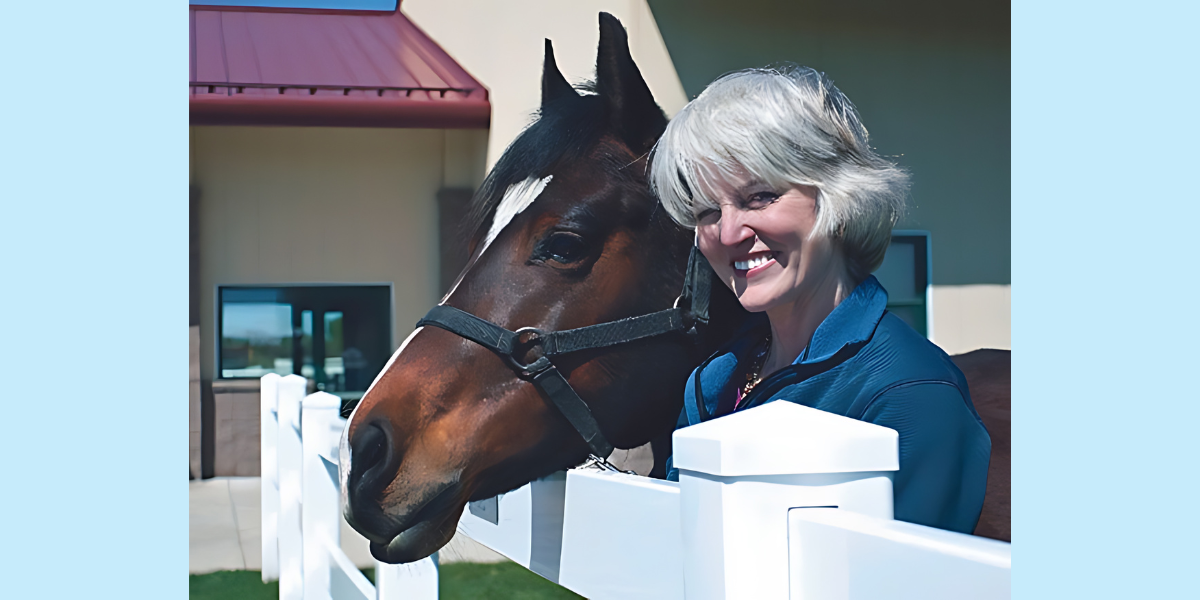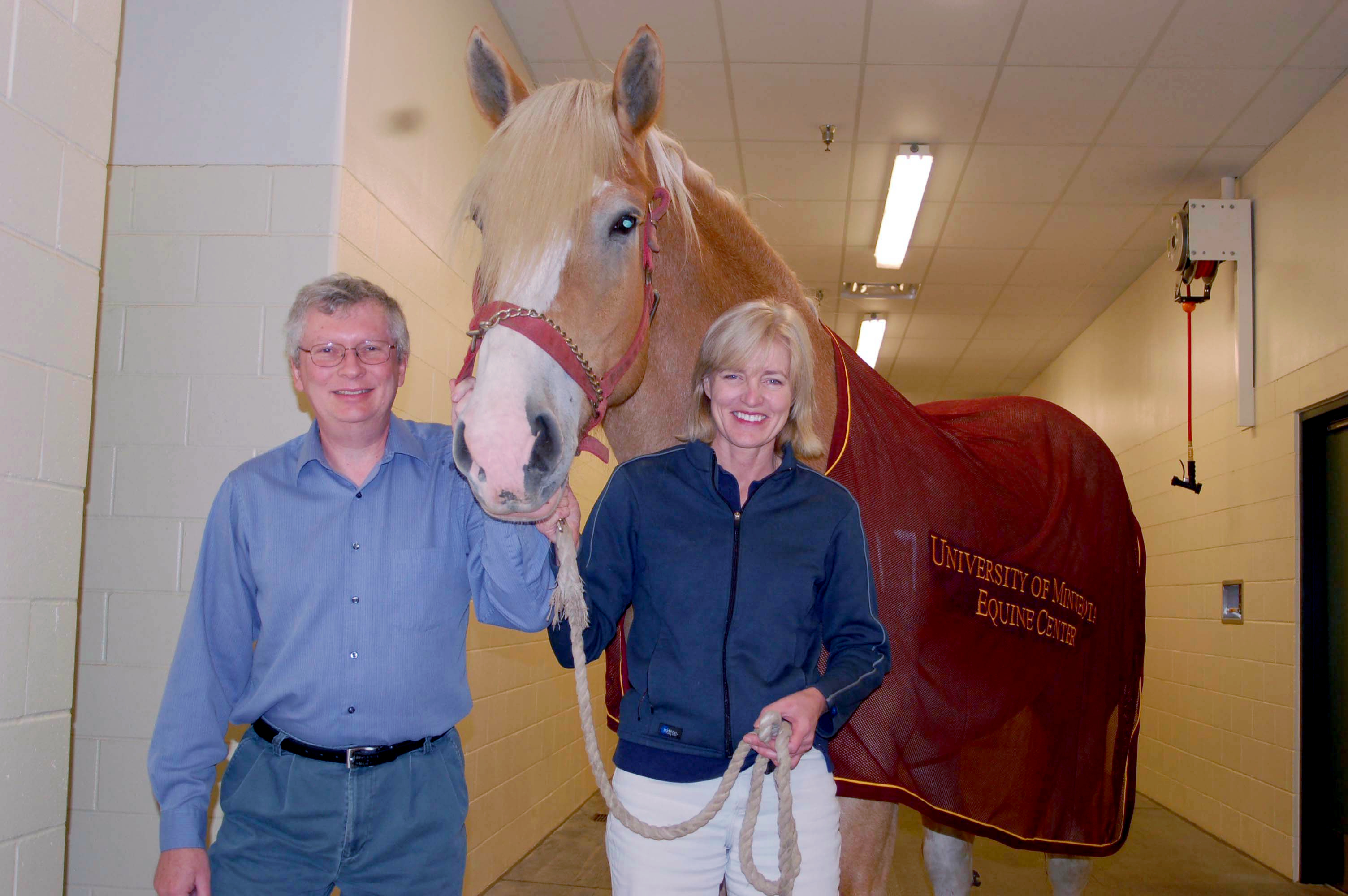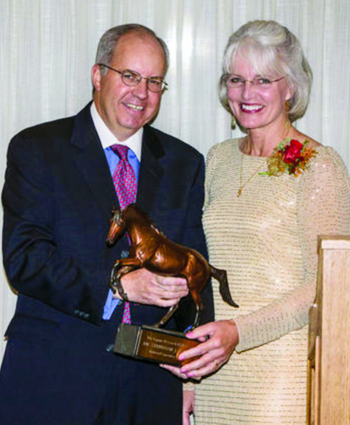‘A guiding light’
Former CVM faculty member Dr. Stephanie Valberg honored with ACVIM Lifetime Achievement Award in the Large Animal Internal Medicine Specialty

Former CVM faculty member Dr. Stephanie Valberg honored with ACVIM Lifetime Achievement Award in the Large Animal Internal Medicine Specialty
The impact of former College of Veterinary Medicine (CVM) faculty member Dr. Stephanie Valberg is one that winds through pages of research findings, standards of care for horses diagnosed with muscular disease, and the work of those she has taught and mentored over her 40-year career.
She has led the way in discovering unknown muscle disorders, pinpointing genetic causes for a variety of equine diseases, and developing treatment and management strategies for these diseases. Her legacy is one that peers say will have a profound reach in equine veterinary medicine and education for many years.

“For decades, Dr. Valberg has been a guiding light advancing our understanding of equine neuromuscular physiology and disease,” says Dr. Christie Ward, an associate professor in the Department of Veterinary Population Medicine. “She is remarkable in her ability to develop practical solutions for complex problems, and unflagging in her willingness to share her knowledge with the veterinary and horse communities.”
The American College of Veterinary Internal Medicine (ACVIM) recently recognized these contributions and presented her with its Lifetime Achievement Award in the Large Animal Internal Medicine Specialty at the ACVIM Forum held June 6–8 in Minneapolis.
Among Valberg’s nominators for the award were current CVM faculty members such as Ward and Dr. Anna Firshman. Firshman first met Valberg while completing her residency and later would count on her as a PhD advisor.
“It has been said that we all stand on the shoulders of giants, and she is that person to me,” Firshman says. “Her compassion for animals, drive for new knowledge, and meticulous approach to disseminating information, that is of utmost integrity, are the strengths that I have been most impressed by.”
Like many in the field, Valberg’s fascination with horses began at a young age.
“I loved horses from the moment I knew about them,” she notes in a biography. Just down the road from her family’s summer cottage in Picton, Ontario, was a horse corral offering rides for a quarter. Once she discovered the corral, all she wanted to do was ride.

That passion prevailed through school and into adulthood, with Valberg riding competitively in shows and drag hunts.
Horses also drove her professional aspirations. Valberg attended the Ontario Veterinary College, Guelph, where she earned her DVM in 1983, followed by a PhD from the Swedish University of Agricultural Sciences in Uppsala, Sweden, in 1986. Her post-doctoral work and residency from 1989 to 1991 was at the University of California, Davis, where she subsequently taught for two years.
Valberg then joined CVM in 1993 as a faculty member. Over the next 20 years, she would rise to the rank of professor, become a leading researcher in equine genetics and muscle disorders, and found the Equine Neuromuscular Laboratory at CVM.

Her systematic approach to recognizing and documenting differences in equine muscle biopsy samples has led to the characterization and understanding of a number of equine muscular conditions. In collaboration with others from the University of Minnesota and other universities around the world, Valberg has documented genetic mutations in a number of these disorders, which has informed change concerning breeding decisions. She also has pursued the development of treatments and nutritional management for many of these disorders, including the creation of the first low-starch, high-fat feed for horses used to help treat a condition known as “tying-up,” which results in painful, uncontrollable muscle cramps.
“This work has led to significant changes in the way we manage horses with these conditions,” Firshman says, “changing the career trajectory of some horses from retired and unusable to accomplished athlete, and in other situations making the difference between a horse surviving or not. It is safe to say she has made a significant impact on the welfare of these animals, which I believe to be a fundamental motive for her work.”
In addition to her research contributions, Valberg’s efforts have made a tremendous impact on equine veterinary education at CVM.
The Leatherdale Equine Center is part of that impact. The center houses the Piper Equine Hospital and is a hub for equine clinical services, research, teaching, and community outreach at CVM. Its doors opened in 2007 thanks in part to Valberg’s tireless fundraising to complete the $14 million project.

“This state-of-the-art facility will become a home for the Minnesota equine community,” Valberg said at the center’s ribbon-cutting ceremony. “No other facility has been designed to give such compassionate, comprehensive care and to give so much back to horse owners. The Equine Center represents our dedication to an expanded equine program, including equine education for the next generation of equine veterinarians and a focus on equine research that will change the lives of horses worldwide.”

Many dedicated community philanthropists were integral in making this project come to fruition, including Doug and Lousie Leatherdale, Cindy and Tad Piper, Bill Dudley, and others whose impact is far-reaching. World-class faculty have been hired and retained, top-class candidates for specialty training have been recruited into residency positions and CVM’s equine students are going on to build successful careers in their own right. This is added to by the remarkable reputation of the equine center and hospital’s clinical service, which provides world-class care to its patients and has made the University the focal place in Minnesota to go to for the gold standard of care. Humans and horses alike are reaping the rewards from the impact of building this facility.
Valberg served as the facility’s first director until 2013. In 2015, she accepted the Mary Anne McPhail Endowed Dressage Chair at Michigan State University College of Veterinary Medicine (MSU). She continued her research work at MSU until her retirement as Professor Emeritus in December 2022. During that time, she also founded the school’s Equine Neuromuscular Diagnostic Laboratory.
Her pioneering work at both schools has changed disease management and treatment and will continue to inspire and drive discovery in equine medicine.
“With one foot in the clinic and the other in the lab, Dr. Valberg has dedicated her career and life to clinical practice, scientific inquiry, and veterinary and horse owner education,” Ward says. “Her contributions as clinician, scientist, and educator are unmatched; they are clearly evident in the tremendous impact she has had on horse health and welfare over the four decades of her illustrious career, and in the specialists and investigators she has trained and mentored.”